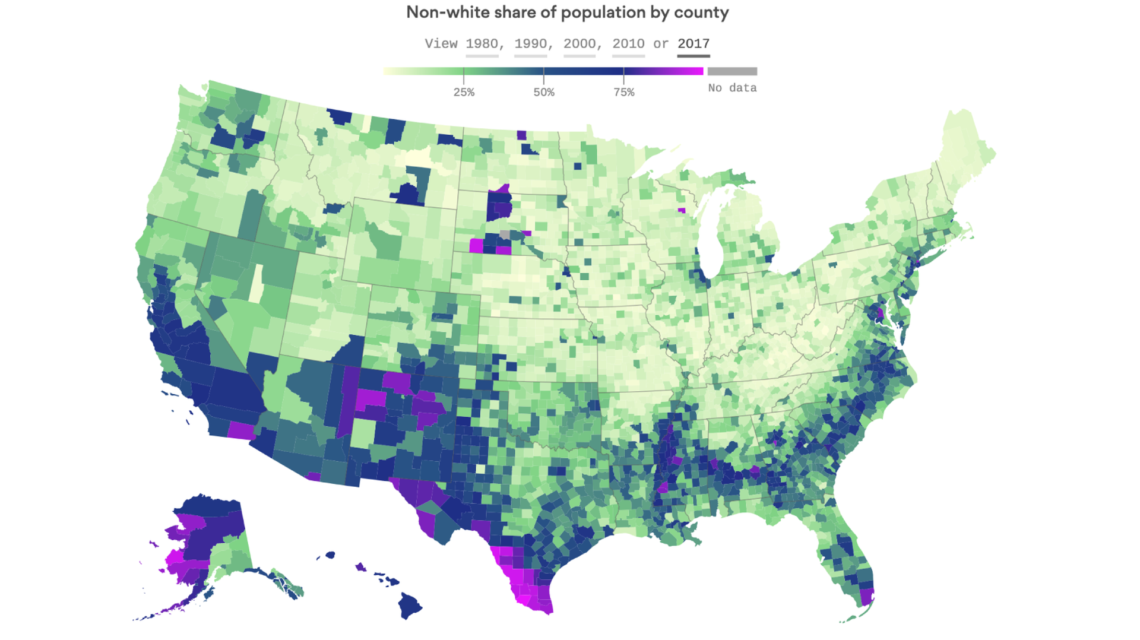By Stef W. Kight
Axios, April 29, 2019.
By 2045, the U.S. as a whole is projected to become majority minority. And the changes are already underway: non-white Americans are now the majority of the population in four states, as well as in the most prosperous and powerful U.S. cities.
Why it matters: The U.S. faces two possible futures: A thriving nation that embraces its new demographic makeup, or an escalation of fighting, racism and xenophobia.

By the numbers: Since 2010, non-Hispanic white people have become the minority in 32 more U.S. counties — for a total of 372 counties, according to U.S. Census Bureau data. The trends are largely due to a rise in Hispanic and Asian immigrants as well as slightly higher birth rates among non-whites.
- Next year, the entire under 18 population will be majority non-white, according to William Frey, a Brookings Institution demographer and author of “Diversity Explosion: How New Racial Demographics are Remaking America.”
- In less than a decade, the population under 30 will be majority non-white.
The demographic shifts are already having an impact on our national identity, politics and the generational gap, according to sociologists and demographers who have studied the trends.
National identity: The U.S. has made significant strides toward structurally equal rights, but in practice, there’s still a long way to go.
- There’s been renewed racial tension and anti-immigrant sentiment over the past few years. White Americans often feel threatened by growing diversity, according to research by Jennifer Richeson, a social psychologist at Yale University.
- A recent Pew Research Center survey found that 59% of Republicans and 46% of whites said a majority non-white population will weaken American culture.
“[We] have to come up with a narrative that realizes and accepts that the U.S. is an immigrant nation… We’re denying that,” says Monica Toft, a professor of international politics at the The Fletcher School at Tufts University.
- It’s also important for diversifying communities to ensure equal rights for all people and have an inclusive identity so they can thrive, says George Mason University’s Justin Gest, who has studied nations and states that have become majority minority.
Politics: One big problem is that politicians capitalize on polarization.
- As we saw with President Trump’s election, a focus on the shrinking non-Hispanic white population has spurred anxiety in a large number of white voters.
“The panic translates into an effective voting block that has high anxiety about immigration, diversity and religious issues.”
— Jack Goldstone, Hazel Professor of Public Policy at George Mason University
Studies have shown that younger generations and minorities are more likely to lean toward the Democrats. But demographers said the demographic trends might not necessarily favor the Democratic Party in the long run.
- Many white, Hispanic Americans have more conservative values, Goldstone said. If the GOP shifts and learns to embrace more Hispanic voters, it could be a source of new energy for the party.
- And as immigrant minorities assimilate, “they may turn out to vote more like whites,” said Richard Alba, a sociologist and professor at the City University of New York. “It’s not so immediately clear that the demographics really favor Democrats.”
The generational gap: Studies have found that older voters and taxpayers tend to be less supportive of education and other issues that impact young people. As the youth looks less like the elderly voters in the community, this dynamic could worsen, according to Frey.
- Much will depend on Millennials, who have become a generational bridge between the older, majority-white population and the younger, more diverse Generation to come, Frey says.
- These younger generations are also more likely to be biracial than ever before. People of two or more races are projected to be the fastest growing racial or ethnic group over the next several decades, according to the Census Bureau.
What to watch: This trend, along with an increase in the white Hispanic population —people who are racially white, but with Spanish or Latin American origins — could change the entire conversation about race in the U.S.
_______________________________________









